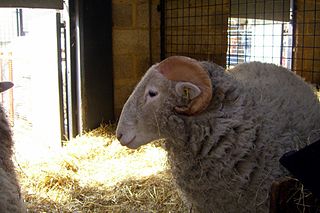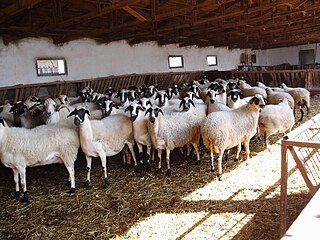Related Research Articles
The Dagliç is a breed of sheep found primarily in western Anatolia in Turkey. They are a carpet wool breed used for both meat and dairy production. Sheep of this breed typically have black spots on the head and legs, the rams are usually horned and the ewes are polled. The breed is thought by some to be the origin of the Chios and Kamakuyruk breeds.

The Targhee is a breed of domestic sheep developed in early 20th century by the USDA's Agricultural Research Service. Targhee sheep are a dual-purpose breed, with heavy, medium quality wool and good meat production characteristics. They are hardy, and are especially suited to the ranges of the West where they were developed. Targhee are especially popular in Montana, Wyoming and South Dakota, where their ¾ fine wool and ¼ long wool breeding is favored by western ranchers. This breed is raised primarily for wool.

The Bluefaced Leicester (BFL) is a longwool breed of sheep which evolved from a breeding scheme of Robert Bakewell, in Dishley, Leicestershire in the eighteenth century. First known as the Dishley Leicester, and then the Hexham Leicester, because of the prevalence of the breed in Northumberland, the name Bluefaced Leicester became known at the beginning of the 20th century. In the 1970s, the Bluefaced Leicester was exported to Canada. Exported frozen semen from the United Kingdom is now used to expand the genetic diversity in Canada and the United States. This breed is raised primarily for meat, but their fleece is becoming increasingly popular for handspinning. Bluefaced Leicester sheep may also have brown on their face. The sell record has been set by a brown ram lamb selling for 23,000 guineas.

The Charollais is a breed of domestic sheep originating in east central France, in the same region in which Charolais cattle originated, Charolles and Saône-et-Loire. It is known for ease of lambing and is used as a terminal sire to increase muscling and growth rate of the lambs. It has been exported internationally, and is commonly used in the United Kingdom as a sire to produce market lambs from pure-bred ewes and mules.

The Blackhead Persian is a fat-tailed breed of domestic sheep from Africa. The sheep is originally from Somaliland and a direct descendant of the Somali sheep. The breed is also a type of hair sheep, meaning they do not grow wool and tolerate heat better than wooled breeds and are raised primarily for meat. The Blackhead Persian has a white body and, as their name would suggest, an entirely black head.

The Whitefaced Woodland is a sheep breed from the Woodlands of Hope an area in the South Pennines in England. It is a combination of two breeds, the Woodland and the Penistone sheep after the Yorkshire town where sheep sales have been held since 1699. It is thought to be closely related to the Swaledale and the Lonk. Substantial commercial flocks of the Whitefaced Woodland are kept in its region of origin, but it is listed as a vulnerable breed by the Rare Breeds Survival Trust, since there are fewer than 900 registered breeding females in Great Britain.
The Llanwenog is a breed of domestic sheep originating in Wales. It was developed in the 19th century from the Llanllwni, the Shropshire, Welsh Mountain, and Clun Forest breeds. The Llanwenog's native locale is the Teifi Valley, in western Wales, but it has since spread into other areas. The breed association was formed in 1957. Llanwenogs have black faces and medium-length wool. They have a docile temperament and are known for their profligacy in lambing. The breed has a very placid temperament, is easily handled, easily contained and is well suited to stress free inwintering if necessary. This has important consequences for the health of both the animal and its keeper. This breed is raised primarily for meat.
Alai is a breed of domesticated sheep found in Kyrgyzstan. This breed is a dual purpose breed raised for its meat and wool.
Arabi is a domesticated breed of sheep from southwestern Iran, southern Iraq and northeastern Arabia and Egypt. Though it does grow wool, it is primarily raised for meat.

Algerian Arab sheep is a breed of domesticated sheep found throughout Algeria. This breed does grow a carpet-grade wool, and is raised primarily for meat.
Armenian Semicoarsewool is a breed of domesticated sheep found in Armenia. A medium-wool fat-tail breed which is kept for meat and milk production. This breed was developed by crossing Rambouillet and Lincoln with Balbas.
The Balkhi is a domesticated breed of sheep found in Afghanistan and North-western Pakistan. This breed is of the fat-tailed mutton type. Though this breed does grow wool, it is primarily raised for meat.

The Bardoka or White Metohian sheep is a multi-purpose breed of domesticated sheep in Kosovo. It is a popular sheep in Kosovo and partially in Montenegro, Serbia and Albania. This breed appears to adaptable to all environmental conditions especially low temperatures. However, the Bardoka is sensitive to high humidity.
The Bibrik is a fat tailed, domesticated breed of meat sheep that is found in Baluchistan Province of Pakistan.
The British Milksheep is a robust, dual-purpose sheep commonly known for its milking characteristics.

The Chios is a breed of domestic sheep with specific unknown origins. It is classified as a semi-fat tailed breed. The Chios are bred mainly for their milk production. Although there is speculation that this breed may have been crossed with Kivircik and Dagliç, it is commonly accepted that it originated on the Greek island of Chios.
The Cholistani is a breed of domestic sheep from Pakistan. Though the Cholistani grows wool, it is raised primarily for meat.

The Coburger Fuchsschaf is a breed of domestic sheep from Germany. It is characterized by its reddish brown to golden color, which is most pronounced at birth, but remains at the head and the legs in the adult. Many animals also have a dorsal stripe.
The Comeback is a type of domestic sheep originating in Australia. This type of sheep results from crossbreds produced by British Longwool sheep and Merinos being mated back to Merinos. This cross is made to achieve a finer, better style of wool. Comeback style wool is also produced by Bond, Cormo and Polwarth sheep and they may prove easier to breed than Comebacks. The Comeback sheep are raised for meat and their fine wool.
Edilbay sheep, also known as Edilbaev(skaya) sheep, are a breed of domesticated sheep which originated in northern Kazakhstan. This breed belongs to the coarse-wooled fat-tailed type of sheep and the Kazakh group. It originated in the 19th century as a cross between Kazakh fat-tailed sheep and Kalmyk/Astrakhan coarse-wooled sheep. Today, it is found in Kazakhstan and Russia.
References
- 1 2 "Altay". Breeds of Livestock. Oklahoma State University, Dept. of Animal Science. Archived from the original on 2008-11-04. Retrieved 2009-05-11.
- 1 2 "Altay Fat-Rumped/China". Breed data sheet. Domestic Animal Diversity Information System. Retrieved 2009-05-11.